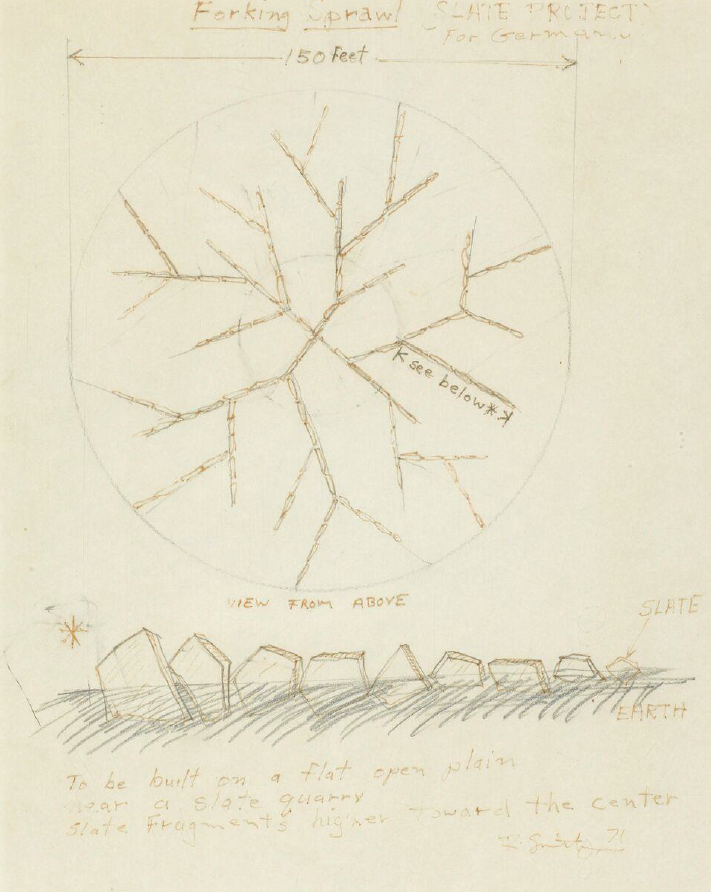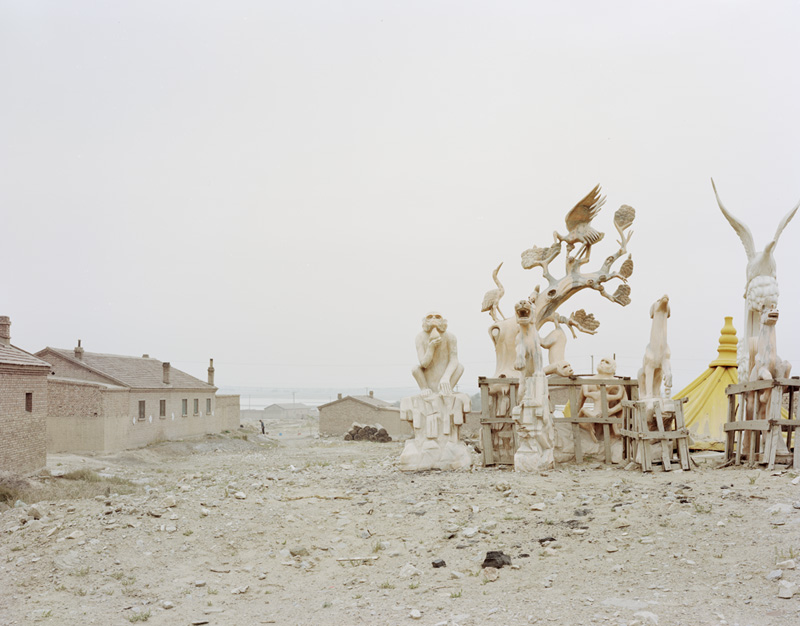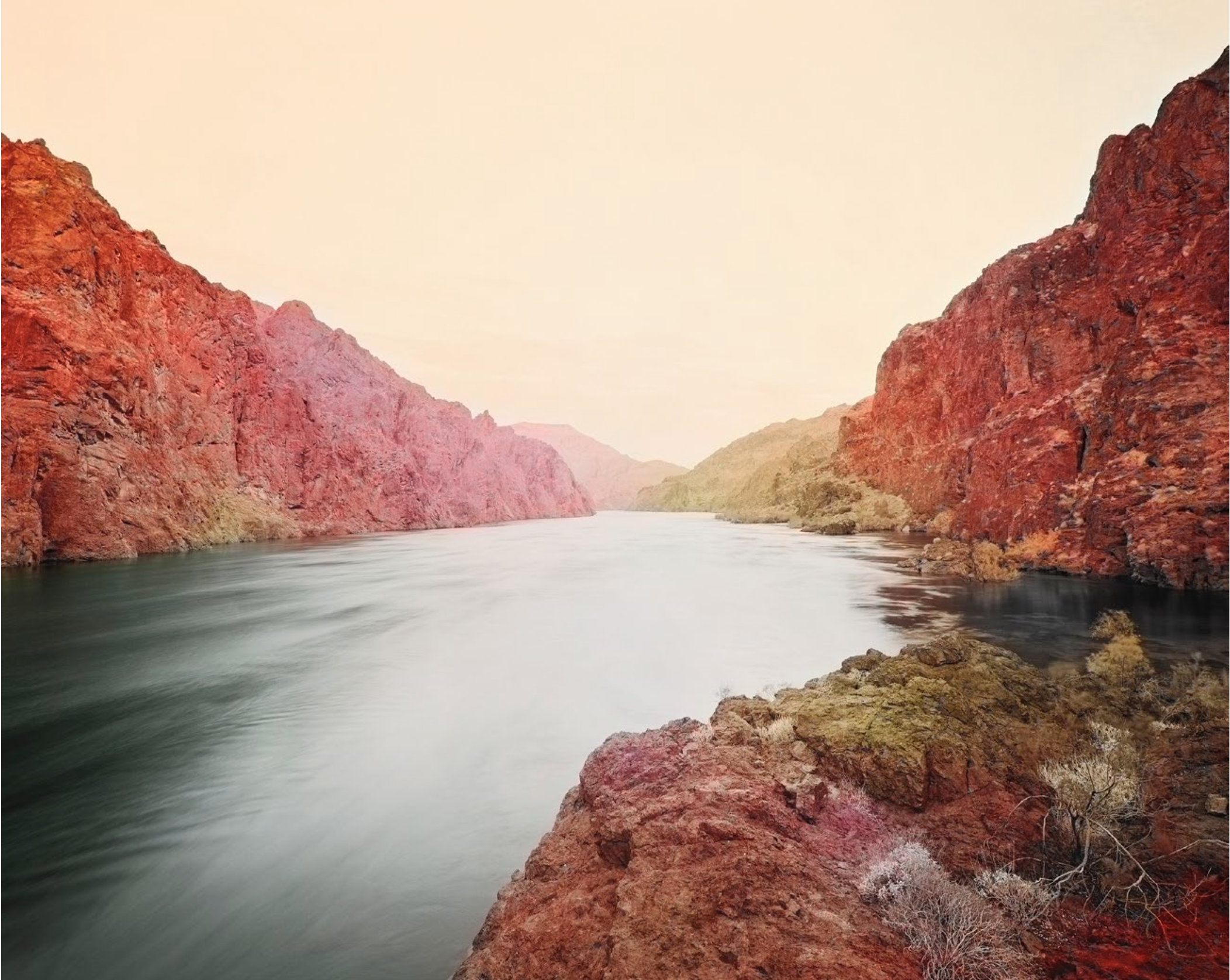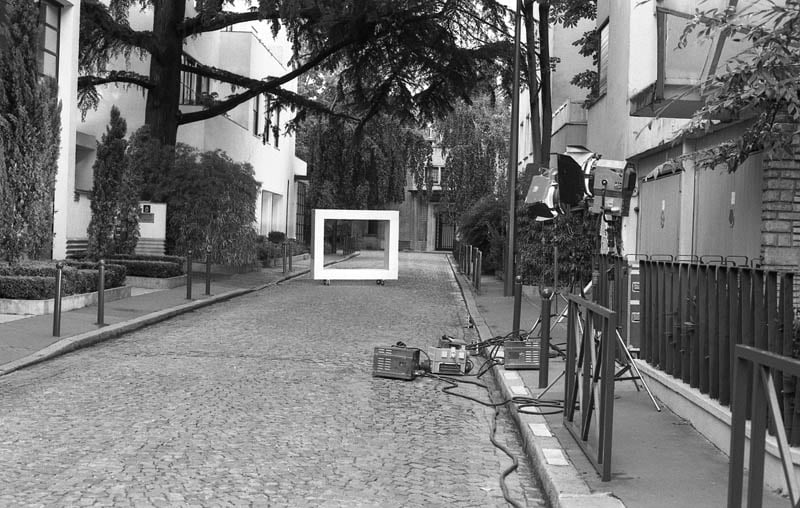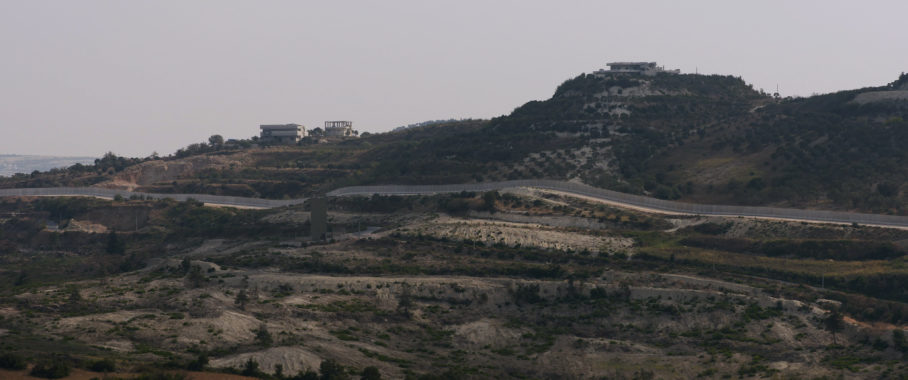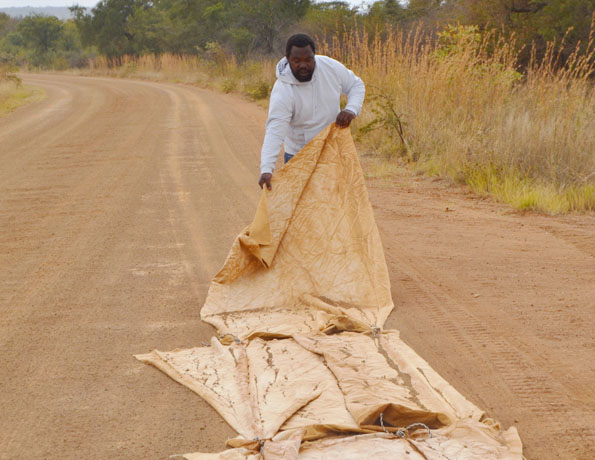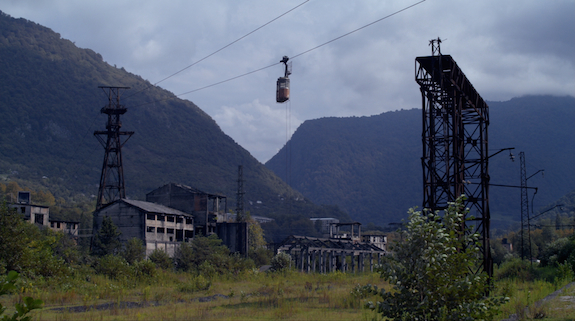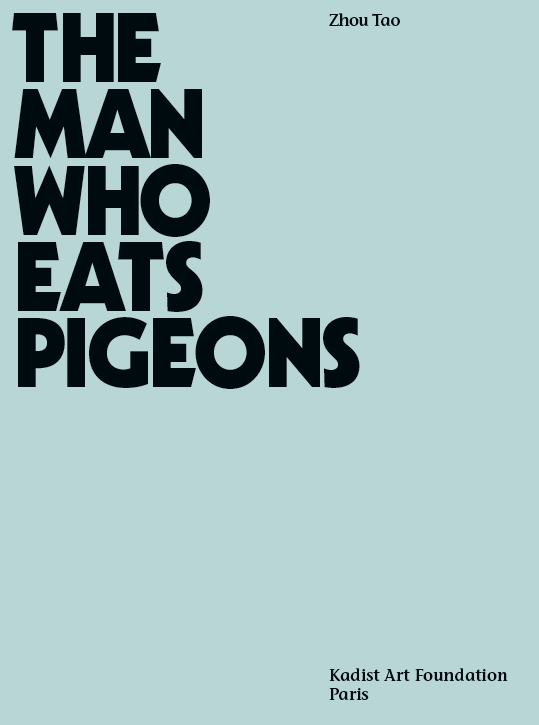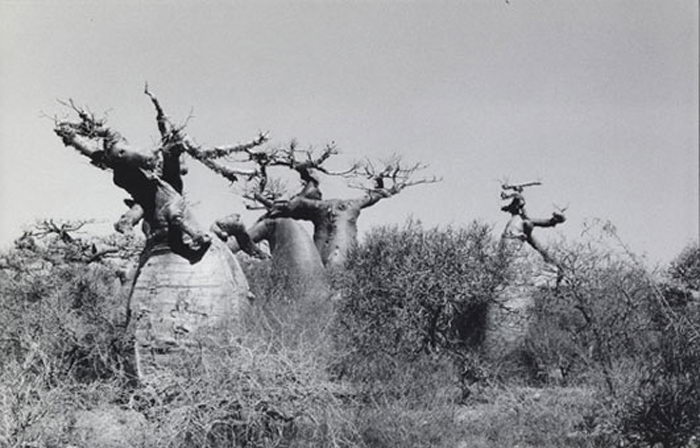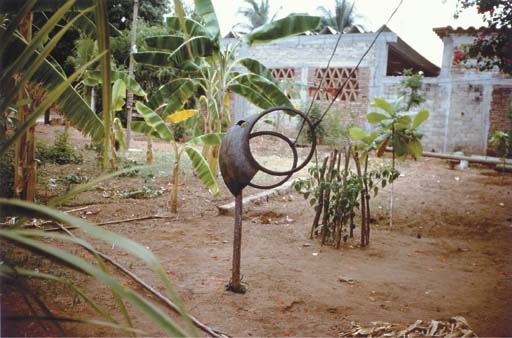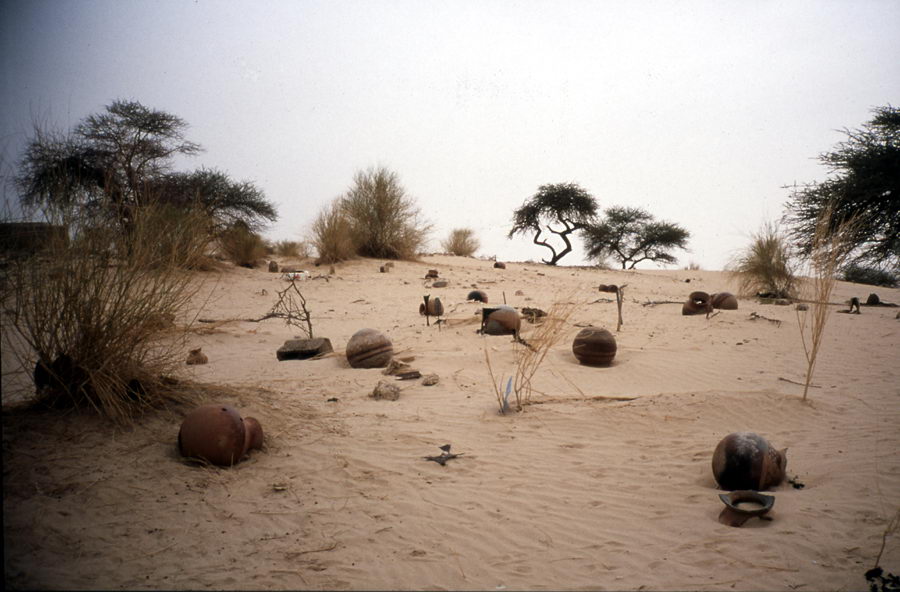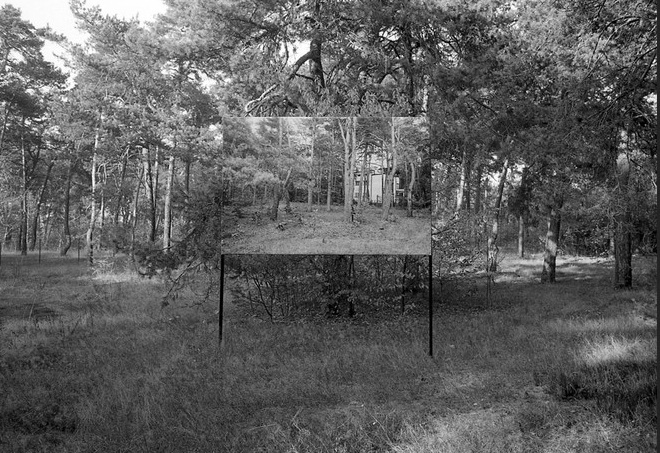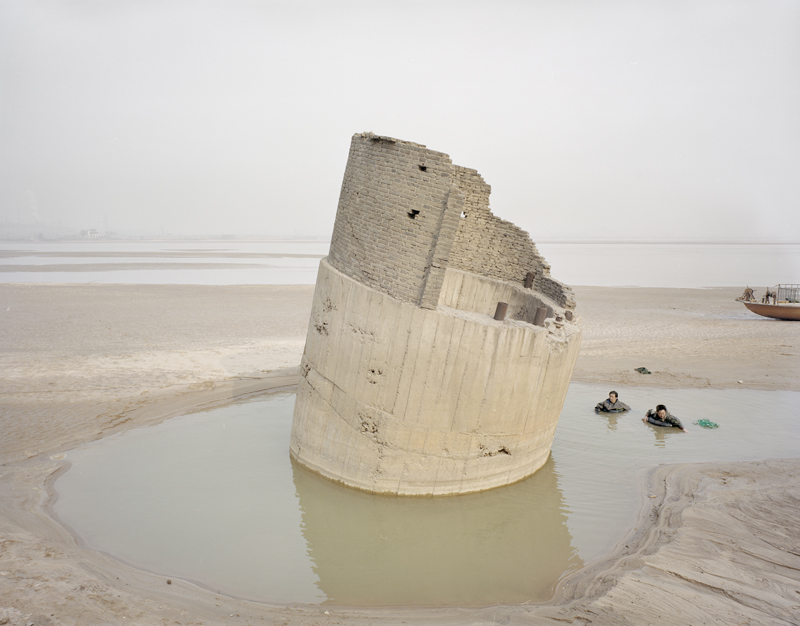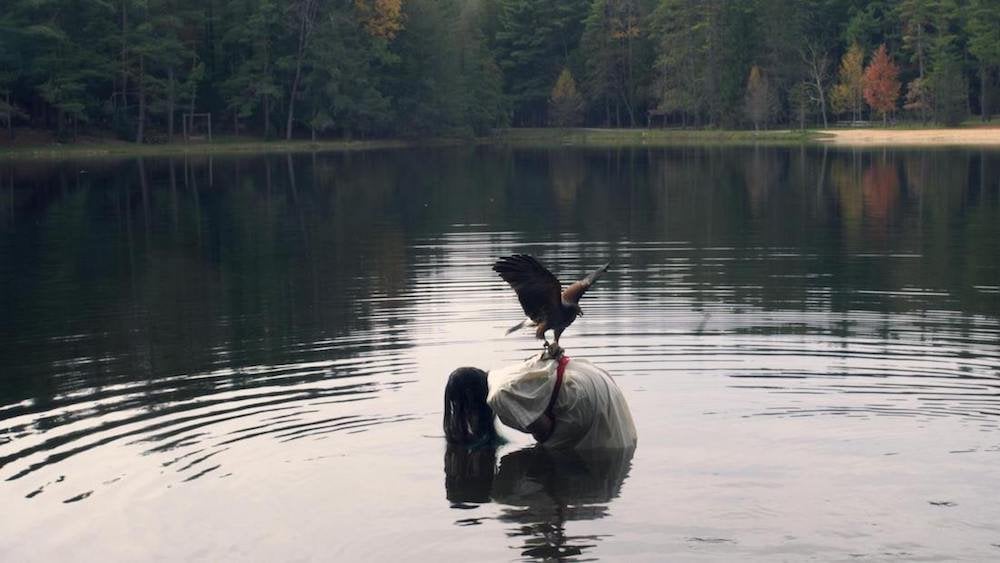
© » KADIST
Nontawat Numbenchapol
The series of prints titled Mr. Shadow by Nontawat Numbenchapol engages with the history of and current state of militarization in Thailand. Each print features an invisible person, their silhouette only outlined by the military fatigues that they wear.

© » KADIST
Ayan Farah
The painting is composed of nineteenth century linen collected over five years. The pieces started out as offcuts from a large work called Fabaceae, which refers to the carob bean, an African staple found in the rainforest and tropical forests. The artist took these already dyed offcuts and dyed them further and then put them out in the sun to fade.

© » KADIST
Rahima Gambo
“ I think we are oversaturated, filled to the brim with images in our inner subconscious eye. Towards the end of 2020, I was feeling very much that I couldn’t take in any more information visually. That was when I made Instruments of Air.

© » KADIST
Vivian Suter
Vivian Suter paints her canvases and then allows them to come in contact with natural elements. For thirty years she has lived in isolation in the Guatemalan jungle, accumulating canvases, sometimes leaving them out for long periods of time. As a result, Suter does not title or date her paintings.

© » KADIST
Calderón & Piñeros (La Decanatura)
Calderón & Piñeros (La Decanatura) refer to Sólheimasandur as a work that tackles the issue of “the ruin as a tourist destination.” As they say, “at the end, tourists become an essential part of this unusual, beautiful, and—at the same time—banal landscape.” The video features a plane wreck on Sólheimasandur beach in Iceland, where a navy plane belonging to the United States Army crashed in 1973 due to fuel exhaustion. The plane appears as an anthropomorphized figure: lying on the sands of the beach without its wings, it resembles a sculptural torso that has lost all its limbs, with cables coming out of its body appearing as internal organs. These injuries remind the viewer of the danger inherent in these artifacts, and the potential for both heroism and death implicit in flying them to far-away territories.

© » KADIST
Jarrett Key
Jarrett Key’s practice combines several modes of production into a single frame, incorporating sculpture, painting, and performance. Dancing Free I , painted in wet cement, like a fresco, is part of a current series of paintings titled Leaving the City , which depicts Black people they know in lush, pastoral landscapes. Raised in rural Alabama, Key’s series grew out of a few experiments conducted with visitors to their studio.

© » KADIST
Hoda Afshar
In the islands of the Strait of Hormuz off the southern coast of Iran, a distinctive local culture has emerged as the result of many centuries of cultural and economic exchange, the traces of which are seen not only in the material culture of these islands but also in the customs and beliefs of their inhabitants. Central to these is a belief in the existence of winds—generally thought of as harmful—that may possess a person, causing her to experience illness or disease, and a corresponding ritual practice involving incense, music and movement in which an hereditary cult leader speaks with the wind through the afflicted patient in one of many local or foreign tongues in order to negotiate its exit. While their exact origins are unclear, the existence of similar beliefs and practices in many African countries suggests that the cult may have been brought to the south of Iran from southeast Africa through the Arab slave trade.

© » KADIST
Dannielle Bowman
Vision (Bump’n’Curl) by Dannielle Bowman is from a series of photographs titled What Had Happened . The series blends a major historical event with small, personal images. The photographs retain fragments of the artist’s own heritage and investigate the concept of home, while gaining inspiration from the Great Migration, a movement in which African Americans from the South (including Bowman’s grandparents) moved to the North, and also the American West from 1916-1970.

© » KADIST
Zon Ito
This embroidery on fabric tackles the oneiric and the uncanny to bring about visions of the world. One can discern the methods of nihonga painting (the traditional Japanese style that renders landscape and forms out of subtle shadows), but Ito upsets the balance by destroying perspective. His work is staunchly non-narrative.

© » KADIST
Zhang Kechun
Zhang Kechun’s photographic series The Yellow River documents the effects of modernization along the eponymous Yellow River, the second longest in Asia. The Yellow River is considered the cradle of Chinese civilization but also poses a great threat, as the river is capable of breaking its banks at any time. Inspired by the novel River of the North by Zhang Chengzhi, the artist travelled on a fold-up bicycle through eastern China’s Shandong province, where the river discharges vast amounts of water into the sea, before slowly tracing it westward over several month-long trips heading to the river’s source near the Bayan Har Mountain in Qinghai.

© » KADIST
Jiri Kovanda
Kovanda’s street interventions are always documented according to the same format as the actions: a piece of A4 paper, a typewritten text giving a precise location and date, and a photograph. Contrarily to the actions, he took the photographs himself. One of the rules he stuck to in his artistic practice was to always use material at his disposal, a real economy of means.

© » KADIST
Nguyen Trinh Thi
Landscape Series no. 1 presents landscape as a “quiet witness of history.” It began with searches of online archives of Vietnamese news-media, for images of figures in landscapes “pointing, to indicate a past event, the location of something gone, something lost or missing.” The uniformity is striking but the sequence is subtly structured: the typology hints at narrative progression, though of an uninformative narrative, lacking details.
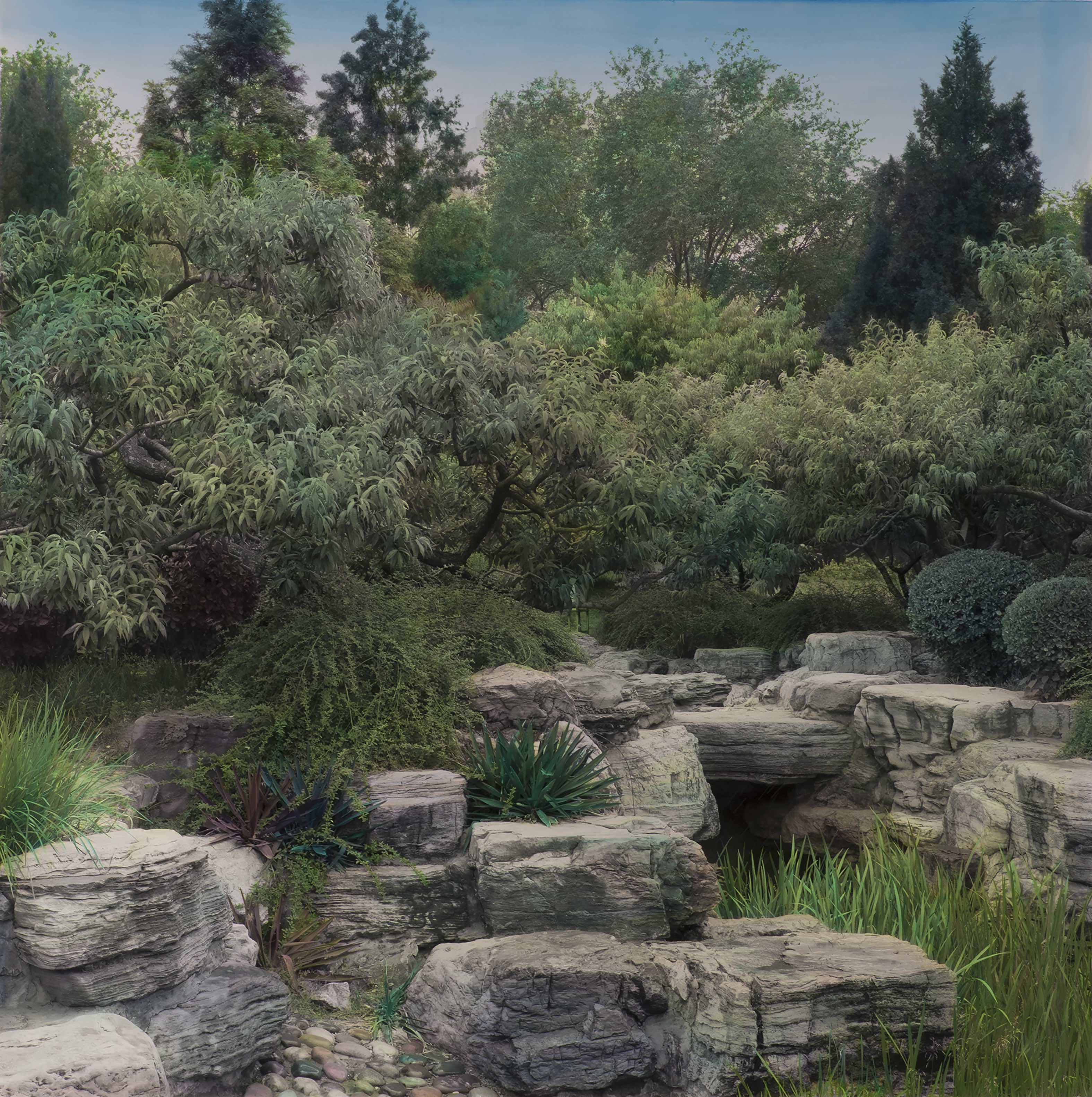
© » KADIST
Shi Guowei
Through a hand-painting process, Shi Guowei created Manufactured Landscape . At first glance, the painting appears from afar as a landscape photograph. Yet, upon closer attention, the work reveals itself as a landscape painting thoroughly hand-colored by the artist onto a photograph.

© » KADIST
Raphaël Zarka
This photograph seems to be awaiting meaning, it more or less evokes known elements without really identifying with them completely: a motorway interchange, a bridge, an electric pylon… In fact this is the end of the tracks of the Aérotrain, a wheelless monorail invented by Jean Bertin in the 1970s, which acts like ‘a fossil of movement on landscape scale’, as explained by the artist. This fragmentary place is meant to activate physical movement. It also activates the spectator’s imagination.

© » KADIST
Sammy Baloji
Part-skyscraper, part-pyramid, part-citadel, this unfinished and ragged twelve-story building stands, incongruously, among the industrial environment of Limete. Towering above this desultory landscape and defying gravitational laws and urban zoning rules, this uncommon architectural proposition forms one of the strangest and most enigmatic landmarks of the city. A giant question mark, it begs for profound reflection on the nature of the city, the heritage of its colonial modernist architecture, the dystopian nature of its infrastructure, and the capacity for utopian urban dreams and lines of flight that it nonetheless continues to generate.

© » KADIST
Paloma Contreras Lomas
Paloma Contreras Lomas has frequently used animals as metaphors in her work. This work’s title, Cimarrón , is the Spanish word for an untamed animal, the wild vegetation that grows in the open, or a runaway slave. Cimarrón is part of a larger series in which the artist turned scaled-up Mexican hats into meticulously hallucinatory landscapes.
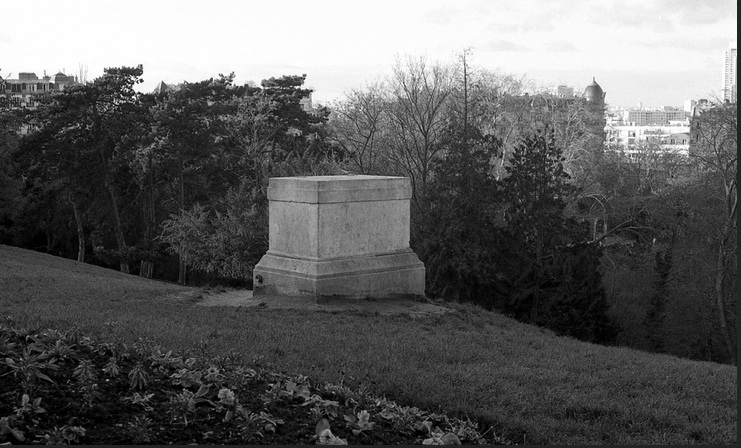
© » KADIST
Charlotte Moth
It is with the eye of a sculptor that Charlotte Moth records modernist architecture and its copies which she encounters during her trips and residences. Photographed in black and white, these architectures seem empty, out of time, and open to any interpretation. The artist creates a classification of her species of spaces, called the “Travelogue”, which is both artwork and tool since it allows her to ceaselessly generate new works.

© » KADIST
Thu Van Tran
From Green to Orange is a series of silver films immersed in a bath of dye and rust. While the perception of the subject is made difficult by the chemical reaction, vegetation becomes discernible at a closer look. Thu Van Tran interferes in the depths of a mystery, in the density of a hallucinated dream.

© » KADIST
Lêna Bùi
Home (good infinity, bad infinity) by Lêna Bùi sheds light on the experiences of those who live along, and on, the waterways of Saigon, Vietnam and Sharjah, United Arab Emirates. Vietnam is a tropical country of major sand extraction; the UAE a desert country of major land reclamation. Scenes of the Saigon river being heavily eroded due to industrial machines mining sand for construction of skyscrapers are interspersed with images of concrete jungles, and aerial views of Saigon and Sharjah varying in scale and style.

© » KADIST
Gozo Yoshimasu
Drawing & Print (Drawing & Print)
Gozo Yoshimasu’s visual-poetry series Dear Monster (Kaibutsu-kun) explores his response to the March 2011 Tohoku earthquake and tsunami. He embarked on the project out of a deep sense of sympathy and commitment, in pursuit of “poetry possible after March 2011”, without exactly knowing where he was heading. He started scribing lines and letters on exceptionally large manuscript paper that he handcrafted every day.

© » KADIST
Tanatchai Bandasak
Central Region by Tanatchai Bandasak is a meditation on materiality and time-based media centres on the mysterious, prehistoric ‘standing stones’ of Hintang in Northern Laos: little-studied megaliths which have survived thousands of years of political change and the cataclysmic carpet-bombing of Laos by the United States during the Cold War. In Bandasak’s unpretentious, animist portrait of the ruins, what is remarkable is the absence of the embodied observer, instead, it is the technical parsing of the digital video camera that enlivens these prodigiously still, mute and enduring objects, through a chanceless sequence of static shots, dissolving measure and revealing gradual modulations of light. The piece evokes a spectral landscape energised by the undead and the nonhuman, opening up contemporary philosophical questions via seemingly ageless and inert artifacts.

© » KADIST
Hassan Massoudy
Drawing & Print (Drawing & Print)
Ranging from Baudelaire to the Koran, each of Hassan Massoudy’s drawings are titled with a quotation from a text. In the case of La beauté sauvera le monde, the text originated from Dostoyevsky’s The Idiot , alluding to aspirations, models of behavior and words of wisdom. The image itself, though generated in a hybrid manner relating to Arabic and Japanese calligraphy, suggests both fluttering flags and buildings rising high out of the desert as one would see in many developing Middle Eastern countries.

© » KADIST
Paulo Nazareth
In 2011, Paulo Nazareth completed a unique journey of several thousand miles. Nazareth left Minas Gerais, Brazil and walked across all of Latin America to the United States to take part in an exhibition during the Miami edition of Art Basel. The series Notícias de América , described by the artist as a residency in transit, or perhaps an accidental residency, is the result of a year’s elaboration of a body of work that is the direct result of an entanglement of human affairs experienced along the way.

© » KADIST
Rindon Johnson
Advanced Technology (Advanced Technology)
The VR play Meat Growers: A Love Story by Rindon Johnson centers on two meat growers who work together in a meat processing factory in the year 2100. The setting is a post-Green New Deal Napa Valley where there are no more paved roads, trees abound, and all the strip malls have been turned into food forests and meat growing plants. The protagonists seem to move through their day automatically, yearning for each other, as the viewer acts as a friend and confidant, silently bearing witness to their desire.
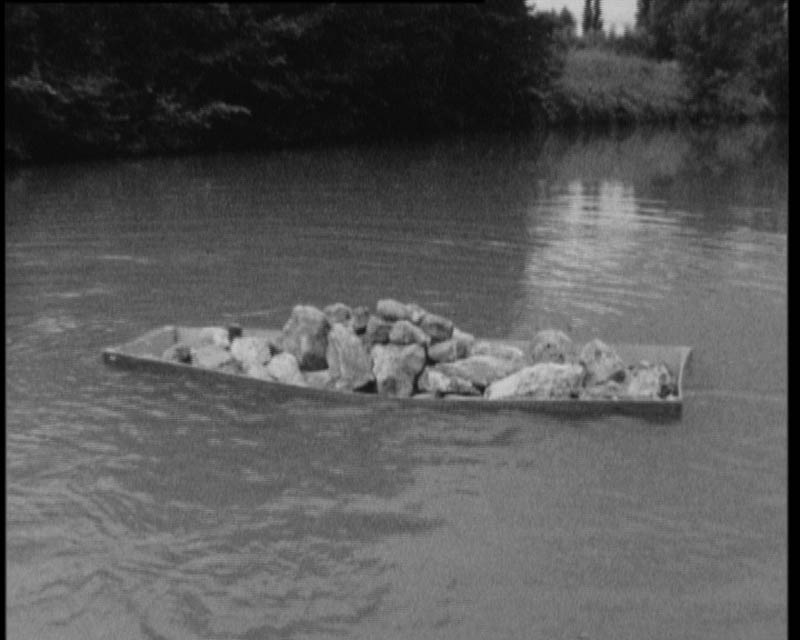
© » KADIST
Katinka Bock
«I will put two heavy stones in my jacket pockets that way my body will sink deep like a deflated truck tire, no one will notice», this excerpt from “Quay West” by Koltès could echo the story depicted by Katinka Bock: the shipwreck of a small boat full of stones. The grain of the image and the framing evoke distant times, maybe the origins of cinema and the footage of the Lumière brothers. The operator’s gaze creates a landscape undetermined in space and time.

© » KADIST
Alexandre da Cunha
The series West (Flag 1), West (Flag 3), and West (Flag 6) continues da Cunha’s ongoing exploration of the form’s various vertical, horizontal, and diagonal stripes. Here, da Cunha overlays thick bars of color (blue, green, and red) on photographs of the ocean at sunset with surfers in floating on the horizon. The solid colors contrast with the fading colors reflected in the sunset, and the tilted orientation suggests a familiar California beach scene.
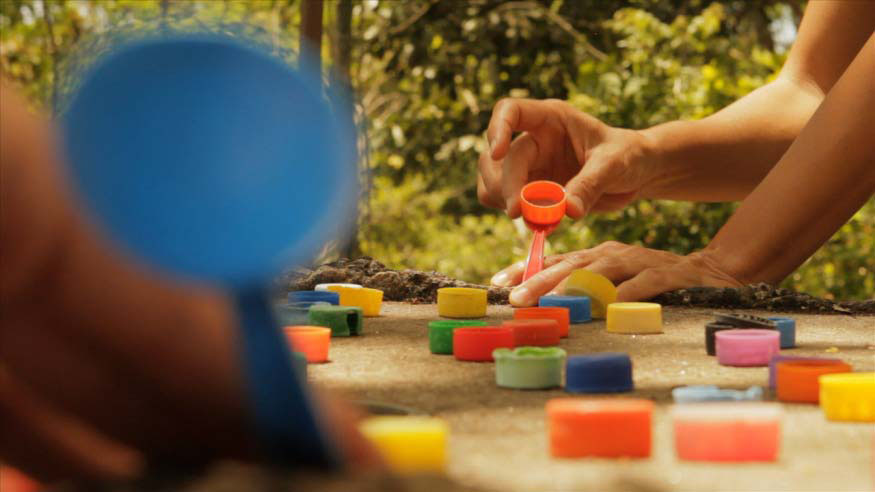
© » KADIST
Donna Conlon and Jonathan Harker
In Tapitapultas (2012), Donna Conlon and Jonathan Harker comment on mass consumerism and pollution by way of a game they invented. The artists used disposable spoons as catapults to shoot thousands of plastic bottle caps at a hole in a concrete platform. The platform was once part of a U. S. military installation in the Panama Canal Zone, and it is now an observation deck in a nature park.

© » KADIST
Trevor Paglen
Half Dome Hough Transform by Trevor Paglen merges traditional American landscape photography (sometimes referred as ‘frontier photography’ for sites located in the American West) with artificial intelligence and other technological advances such as computer vision. This photograph was taken at Half Dome, a frequently visited granite rock formation in Yosemite National Park, California. For this work, Paglen created a digital file of the 8 x 10 inch photographic negative so that the artificial intelligence program can apply computer vision to evaluate the content of the image.

© » KADIST
Catherine Opie
Although best known as a provocateur and portraitist, Opie also photographs landscapes, cityscapes, and architecture. The Freeway Series was developed in 1995, right after the artist’s inclusion in that year’s Whitney Biennial. As if suggesting that her work should not be restricted to being seen through overtly political or activist lenses, this series lends insight into the city of Los Angeles via its most characteristic urban feature: its highways.
Gozo Yoshimasu
Gozo Yoshimasu is a prolific Japanese poet, photographer, artist and filmmaker active since the 1960s...
Nontawat Numbenchapol
Nontawat Numbenchapol is primarily known as a film director and television screenwriter, widely recognized for his documentary work...
Paulo Nazareth
Born in 1977 in the city of Governador Valadares, Minas Gerais, Paulo Nazareth now lives as a global nomad...
Zhang Kechun
Photographer Zhang Kechun documents striking scenery that meditates on the significance of landscape in modern Chinese national identity...
Carolina Caycedo
Carolina Caycedo’s work triumphs environmental justice through demonstrations of resistance and solidarity...
Nguyen Trinh Thi
Nguyen Trinh Thi is a moving image pioneer, not only within the landscape of contemporary art in Vietnam, but also broader South East Asia...
Trevor Paglen
Trevor Paglen’s work combines the knowledge-base of artist, geographer and activist...
Paloma Contreras Lomas
A writer and an artist, Paloma Contreras Lomas has developed a practice in which literature and fiction play a major role, allowing her to address a series of topics regarding race and class that are rarely broached by a traditional Mexican society...
Elena Damiani
- location: Copenhagen, Denmark
- location: Lima, Peru
- year born: 1972
- gender: female
- nationality: Peruvian
- home town: Peru
Charlotte Moth
Charlotte Moth has been constituting an image bank since 1999...
Gabriel Orozco
- location: New York City, Paris
- location: Mexico
- year born: 1962
- gender: male
- nationality: Mexican
- home town: Jalapa, Mexico
Thu Van Tran
Thu Van Tran grew up in the paradox of the dismantlement of the French colonial empire in Vietnam...
Rindon Johnson
Rindon Johnson’s work in sculpture, video, poetry, and virtual reality deals with technologies that enable captivity and the harnessing and transformation of nature from a gender- and race-critical perspective...
Maryanto
Maryanto is an artist with a background in printmaking whose research-oriented practice is deeply concerned with ecological footprints and actions of humanity...
Chemi Rosado-Seijo
Chemi Rosado-Seijo’s work consists of community-based interventions linked to the site where they have been developed...
Jiri Kovanda
- location: Praha, Ceská Republika
- year born: 1953
- gender: male
- nationality: Czech
Sammy Baloji
Sammy Baloji explores the cultural, architectural and industrial heritage of the Katanga region in Congo...
Vvzela Kook
Vvzela Kook works in multiple media, including AV, performance, theatre, computer graphics, 3D printing, and drawing, often combining recent technology with artistic imagination and skill to navigate and describe cityscapes, their memory, connections, and hidden cybernetic structures, playing both with human sensorial perception and narrative devices...
Tanatchai Bandasak
Artist Tanatchai Bandasak began his career as a filmmaker, however following his studies at art school in France, he began exploring installation and sculptural strategies for presenting moving images...
Jarrett Key
Jarrett Key’s work addresses their concerns about the state of their freedom in America...
Catherine Opie
- location: Los Angeles, California
- year born: 1961
- gender: female
- nationality: American
- home town: Sandusky, Ohio
Hassan Massoudy
Hassan Massoudy trained as a classical calligrapher in Baghdad before attending the Ecole des Beaux-Arts in Paris in 1969...
Ruijun Shen
Ruijun Shen conceptualizes her painting-based practice as a form of extended meditation and a means of processing tensions between time and space in the world around us...
Vandy Rattana
A self-taught photographer, Vandy Rattana has focused on challenging conditions in Cambodia, his home country, by documenting natural and manmade disasters...
Motoyuki Shitamichi
After graduating from Musashino Art University in 2001, Shitamichi traveled for four years throughout Japan and took photographs of war remains...
Shi Guowei
Shi Guowei is concerned with notions of historical and cultural traditions as they relate to current socio-political issues...
Zon Ito
Zon Ito was born in 1971 in Osaka...
Trisha Donnelly
- location: New York, New York
- year born: 1974
- gender: male
- nationality: American
- home town: San Francisco, California
Eric Baudelaire
Currently based in Paris, Franco-American artist Eric Baudelaire has developed an oeuvre primarily composed of film, but which also includes photography, silkscreen prints, performance, publications and installations...
-
-
1980-1989
Jiri Kovanda
1980Kovanda’s street interventions are always documented according to the same format as the actions: a piece of A4 paper, a typewritten text giving a precise location and date, and a photograph...
-
1990-1999
Catherine Opie
1994Although best known as a provocateur and portraitist, Opie also photographs landscapes, cityscapes, and architecture...
-
2000-2009
Raphaël Zarka
2001This photograph seems to be awaiting meaning, it more or less evokes known elements without really identifying with them completely: a motorway interchange, a bridge, an electric pylon… In fact this is the end of the tracks of the Aérotrain, a wheelless monorail invented by Jean Bertin in the 1970s, which acts like ‘a fossil of movement on landscape scale’, as explained by the artist...
Gabriel Orozco
2002Gabriel Orozco comments: “In the exhibition [Documenta 11, Kassel, 2002], I tried to connect with the photographs I took in Mali in July...
Ruijun Shen
2006In Seven Deadly Sins (2006), Shen utilizes abstraction to produce complex topographies of color that evoke associations with violently tumultuous landscapes...
Katinka Bock
2007«I will put two heavy stones in my jacket pockets that way my body will sink deep like a deflated truck tire, no one will notice», this excerpt from “Quay West” by Koltès could echo the story depicted by Katinka Bock: the shipwreck of a small boat full of stones...
Trisha Donnelly
2007Untitled is a black-and-white photograph of a wave just before it breaks as seen from the distance of an overlook...
Hassan Massoudy
Drawing & Print
2008(Drawing & Print) Ranging from Baudelaire to the Koran, each of Hassan Massoudy’s drawings are titled with a quotation from a text...
J. John Priola
2008Priola pays particular attention to otherwise unnoticed details in the cityscape, a quality that not only recurs throughout his oeuvre, but which also places his work in line with a strong tradition of California documentary photography...
Vandy Rattana
2009Vandy Rattana’s Bomb Ponds series was made following a transformative encounter with the craters left over from 2,756,941 tons of bombs dropped by U...
-
2010-2019
Alexandre da Cunha
2011The series West (Flag 1), West (Flag 3), and West (Flag 6) continues da Cunha’s ongoing exploration of the form’s various vertical, horizontal, and diagonal stripes...
Zhang Kechun
2011Zhang Kechun’s photographic series The Yellow River documents the effects of modernization along the eponymous Yellow River, the second longest in Asia...
Charlotte Moth
2012It is with the eye of a sculptor that Charlotte Moth records modernist architecture and its copies which she encounters during her trips and residences...
Donna Conlon and Jonathan Harker
2012In Tapitapultas (2012), Donna Conlon and Jonathan Harker comment on mass consumerism and pollution by way of a game they invented...
Charlotte Moth
2012It is with the eye of a sculptor that Charlotte Moth records modernist architecture and its copies which she encounters during her trips and residences...
Elena Damiani
2012Intersticio (Interstice) by Elena Damiani traces the topography of a non-specific site, an in-between zone...
Robert Zhao Renhui
2012Changi, Singapore, possibly 1970s is from the series “As We Walked on Water” (2010-2012), which looks into Singapore’s history around the phenomenon of land reclamation...
Zhang Kechun
2012Zhang Kechun’s photographic series The Yellow River documents the effects of modernization along the eponymous Yellow River, the second longest in Asia...
Lam Tung Pang
Drawing & Print
2013(Drawing & Print) Lam Tung Pang created Sketches from train ride Chicago to San Francisco during his travels through the United States researching American curatorial strategies for representing traditional Chinese painting in museums and cultural institutions...
Carolina Caycedo
2013In this two-channel video installation, Spaniards Named Her Magdalena, But Natives Called Her Yuma , Carolina Caycedo gathered footage during numerous research trips to dam sites in the Harz Mountains, Saxony, Westphalia and the Black Forest in Germany interspersed with images of the Rio Magdalena region in Colombia...
Jessica Warboys
2013The ongoing “Sea Paintings” series is central to the practice of Jessica Warboys...
Thu Van Tran
2014From Green to Orange is a series of silver films immersed in a bath of dye and rust...
Gozo Yoshimasu
Drawing & Print
2014(Drawing & Print) Gozo Yoshimasu’s visual-poetry series Dear Monster (Kaibutsu-kun) explores his response to the March 2011 Tohoku earthquake and tsunami...
Gozo Yoshimasu
Drawing & Print
2014(Drawing & Print) Gozo Yoshimasu’s visual-poetry series Dear Monster (Kaibutsu-kun) explores his response to the March 2011 Tohoku earthquake and tsunami...
Sam Contis
2014Sam Contis’s photographs explore the relationship of bodies to landscape, and the shifting nature of gender identity and expression...
Will Rogan
2014Will Rogan’s video Eraser (2014) shows a hearse parked in a clearing amidst leaf barren trees...
Sam Contis
2014Sam Contis’s photographs explore the relationship of bodies to landscape, and the shifting nature of gender identity and expression...
Elena Damiani
2014In Fading Fields 7 by Elena Damiani, the unstable transparency of the print on silk chiffon is relative to the light and the viewer’s position, varying continually as one moves around the work...
Carolina Caycedo
2015Carolina Caycedo’s practice conveys her very personal passion and relationship to water, as a powerful necessity and spiritual reminder...
Michael Armitage
2015In “And so it is” shows the image of a faceless man before a microphone, ready to deliver an important message...
Nohemí Pérez
Drawing & Print
2016(Drawing & Print) A rich and isolated region, El Catatumbo is located near the border with Venezuela...
Chemi Rosado-Seijo
2016Map of the Universe from El Cerro continues Chemi Rosado-Seijo’s long-term engagement with the community of El Cerro , a rural, working-class community living in the mountains of Naranjito, Puerto Rico...
Etel Adnan and Lynn Marie Kirby
Drawing & Print
2017(Drawing & Print) In conjunction with KADIST’s 2017 exhibition If Not Apollo, the Breeze , artist and filmmaker Lynn Marie Kirby performed Transmissions , a video and live reading created with longtime collaborator Etel Adnan...
Eric Baudelaire
2017Baudelaire’s latest film, Also known as Jihadi (2017) tells the story of a young French boy from Parisian suburbs and his assumed journey to the Al-Nusra front in Syria to join ISIS and fight Bashar al-Assad’s regime...
Gozo Yoshimasu
Drawing & Print
2017(Drawing & Print) Gozo Yoshimasu’s double-sided work on paper Fire Embroidery explores his response to the March 2011 Tohoku earthquake and tsunami...
Calderón & Piñeros (La Decanatura)
2018Calderón & Piñeros (La Decanatura) refer to Sólheimasandur as a work that tackles the issue of “the ruin as a tourist destination.” As they say, “at the end, tourists become an essential part of this unusual, beautiful, and—at the same time—banal landscape.” The video features a plane wreck on Sólheimasandur beach in Iceland, where a navy plane belonging to the United States Army crashed in 1973 due to fuel exhaustion...
Alicia Smith
2018The title of Alicia Smith’s video work, Teomama , means “God Carrier” in the Aztec language of Nahuatl...
Dannielle Bowman
2019Vision (Bump’n’Curl) by Dannielle Bowman is from a series of photographs titled What Had Happened ...
Rindon Johnson
Advanced Technology
2019(Advanced Technology) The VR play Meat Growers: A Love Story by Rindon Johnson centers on two meat growers who work together in a meat processing factory in the year 2100...
Tanatchai Bandasak
2019Central Region by Tanatchai Bandasak is a meditation on materiality and time-based media centres on the mysterious, prehistoric ‘standing stones’ of Hintang in Northern Laos: little-studied megaliths which have survived thousands of years of political change and the cataclysmic carpet-bombing of Laos by the United States during the Cold War...
Vvzela Kook
2019Columbus of Horticulture stems from Vvzela Kook’s ongoing research into the central and often-ignored role that botany played in the history of European imperialism...
-
2020-2029
Rahima Gambo
2020“ I think we are oversaturated, filled to the brim with images in our inner subconscious eye...
Paloma Contreras Lomas
2020Paloma Contreras Lomas has frequently used animals as metaphors in her work...
Zhang Kechun
2020Zhang Kechun’s photographic series The Yellow River documents the effects of modernization along the eponymous Yellow River, the second longest in Asia...
Trevor Paglen
2020Half Dome Hough Transform by Trevor Paglen merges traditional American landscape photography (sometimes referred as ‘frontier photography’ for sites located in the American West) with artificial intelligence and other technological advances such as computer vision...
Jarrett Key
2020Jarrett Key’s practice combines several modes of production into a single frame, incorporating sculpture, painting, and performance...
Trevor Paglen
2020The Black Canyon Deep Semantic Image Segments by Trevor Paglen merges traditional American landscape photography (sometimes referred as ‘frontier photography’ for sites located in the American West) with artificial intelligence and other technological advances such as computer vision...
Paloma Contreras Lomas
Drawing & Print
2020(Drawing & Print) Paloma Contreras Lomas sometimes incorporates large scale drawing into her practice...
Leticia Ramos
2021Leticia Ramos’s film DROPSPIKE is the second of a five-part film project entitled STORIES OF THE END OF THE WORLD ...
Nguyen Trinh Thi
2021The essay film How to Improve the World by Nguyen Trinh Thi takes us into an indigenous village of the Jrai people in the Central Highlands of Vietnam, in Gia Lai province...
Hoda Afshar
2022In the islands of the Strait of Hormuz off the southern coast of Iran, a distinctive local culture has emerged as the result of many centuries of cultural and economic exchange, the traces of which are seen not only in the material culture of these islands but also in the customs and beliefs of their inhabitants...
Enar de Dios Rodríguez
2022Ecotone by Enar de Dios Rodríguez is a video work presented in six chapters, each beginning and ending with a one-sided telephone dialog with an informal, friendly and conversational tone, that leads quickly into complex philosophical subjects...
